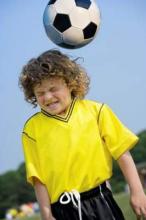BALTIMORE – Children whose parents rated them higher on a psychological assessment of somatization were more likely to show persistent postconcussive symptoms, according to a recent study.
Joe Grubenhoff, MD, and his colleagues at the University of Colorado, Aurora, reported that 34.2% of children with delayed symptom recovery (DSR) after concussion had abnormal scores on the Somatic Concerns subscale of the Personality Inventory for Children–Version 2 (PIC-2), compared with 12.8% of children with early symptom recovery (ESR, P = .01).
This finding from a prospective longitudinal study of 179 children with concussion extends previous work showing similar findings in adults with concussion. “Children with a pre-injury tendency to somaticize were more likely to report delayed symptom resolution,” said Dr. Grubenhoff, , professor of emergency medicine and pediatrics at the university.
Dr. Grubenhoff noted that the study is important because out of the 630,000 annual ED visits for concussion in children, up to 30% may have postconcussive symptoms 3 months after the event. Concussion management guidelines are symptom driven. In practical terms, this means that return to sports is prohibited until symptoms are gone, and academic activities may be modified while children are symptomatic.
This management strategy assumes that a heavier symptom load means a more serious injury, and that symptoms that persist indicate lack of complete recovery from concussion, Dr. Grubenhoff said at the annual meeting of the Pediatric Academic Societies.
“In an ED cohort, initial symptom load was not associated with delayed symptom resolution,” he said, citing previous research. It’s known that persistent postconcussive symptoms in adults are associated with certain pre-injury psychological traits, including somatization, but whether this holds true in a pediatric population was not known, he said.
To characterize which psychological factors might be associated with postconcussion DSR in children, Dr. Grubenhoff and his colleagues designed a prospective longitudinal cohort study of children presenting to a regional pediatric trauma ED with concussion. To be included, the patients, aged 8-18 years, had to present to the ED within 6 hours of their injury. Children with open head injury or multisystem trauma, those who were intoxicated or who had received narcotics, and those with underlying CNS abnormalities were excluded.
Symptoms were assessed with a 12-symptom graded symptom inventory, with the addition of two additional symptoms, sadness and irritability. Symptoms were graded on a 0- to 2-point scale. At 30 days post injury, patients reported symptom presence and severity; patients were assessed as having DSR if they had at least three symptoms that were worse than the patient’s pre-injury baseline.
Independent psychological variables were assessed by parental assessment of the child’s pre-injury state via the PIC-2. This tool’s subscales measure cognitive impairment, psychological discomfort, and somatic concern. Also, the study administered two postinjury assessments to children: the “state” portion of the State-Trait Anxiety Inventory for Children (STAI), and the Children’s Illness Perception Questionnaire (CIPQ). This last measure allowed Dr. Grubenhoff and his colleagues to explore the children’s own ideas about their concussion.
The study enrolled 234 children, but 55 of them (24%) were lost to follow-up. Of the 179 remaining children, 141 (79%) had ESR, while the remaining 38 (21%) had DSR. Demographics, mechanism of injury, and injury characteristics were not significantly different between the two groups. The study included children with intracranial hemorrhages (n = 5, all in the ESR group), and whose Glasgow Coma Scale (GCS) was less than 15 (n = 12, 11 in the ESR group). Return to GCS of 15 within 24 hours was not documented, but the mean GCS for study patients was 15.
In multivariate logistic regression analysis, children who scored higher on the Somatic Concerns subscale of the PIC-2 were more likely to experience DSR (odds ratio [OR] 1.35, P less than .01). There was no significant difference between the groups in the other psychological testing.
Study limitations include the fact that about a quarter of patients were lost to follow-up, although these patients did not differ in their scoring on psychological testing from those who remained. Also, the possibility of misclassification exists, since symptoms may have resolved at a time point just before or after the 30-day follow-up marker. But Dr. Grubenhoff said that the proportion of children with DSR was similar to that seen in other cohorts of children presenting to the ED with concussion.
“Postconcussive symptoms lasting at least 1 month may warrant referral to a neuropsychologist,” said Dr. Grubenhoff.
He reported no conflicts of interest.
On Twitter @karioakes


